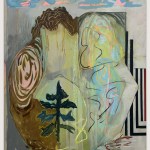
Contributed by Laurie Fendrich / Pause for a moment to pity the painter Agnes Pelton (1881–1961). While she was alive, she was mostly overlooked; after her death, she was still mostly overlooked. This spring was to have been Pelton’s big moment, for she was finally to move into the spotlight of the New York art world. A traveling retrospective exhibition, organized by the Phoenix Museum of Art, followed by a run at The New Mexico Art Museum (where I first saw it this past fall), had now arrived at the Whitney, where it opened March 10. I was among the lucky few to catch the show at a press view before it was closed to the public March 13—courtesy of the wretched coronavirus pandemic.
The exhibition consists of almost half of Pelton’s extant paintings (in total, there are only around 100; often painting only one day a week, the artist was hardly a studio rat). Now the paintings hang, in all their futile glory, inside darkened Whitney galleries. No one can say for certain if the museum will open before the show’s scheduled closing June 28th. Had a virus not moved with ferocity over our planet, the exhibition would almost certainly have drawn big crowds. More, it would have been a revelation, especially to the many who don’t know of Pelton (The Whitney acquired two Pelton paintings in 1995 and 1999, and ever since the Chelsea building opened, they’ve been on view). There likely would have been a buzz such as that accompanying the Hilma af Klint exhibition at the Guggenheim, and Pelton’s work would have taken its rightful place in the “Spiritualism and Transcendentalism” section of the increasingly complicated narrative of modern art. Instead, the Pelton exhibition turned as evanescent and elusive as her paintings themselves.
Now there will probably be no sufficient reevaluation of Pelton’s place in American modernism.
This isn’t to say attention has never been paid to Pelton or isn’t being paid now. She exhibited her paintings in several group and solo shows well before she turned fully abstract in 1926 and was well enough known that the southwestern Transcendental Painting Group in Santa Fe made her an honorary member from 1938–1941. Living for a while off the modest inheritance left her by her mother, she also painted conventional still lifes to support herself (her abstract paintings found some takers, but not enough; after her death, one painting was even found in a second-hand shop). She didn’t market herself and wasn’t distressed she didn’t sell. She was posthumously included in the L.A. County Museum of Art’s 1986 exhibition, curated by Maurice Tuchman, “The Spiritual in Art: Abstract Painting 1890–1985.” (I saw this show when I was a younger artist living in LA, but given I am about as spiritual as a potato chip, the show left little impression on me; I certainly don’t recall noticing the Pelton contribution.) The Palm Springs Desert Museum in California mounted a retrospective in 1995, which brought Pelton some national attention. Now come several celebratory reviews of the Whitney exhibition, including The New York Times, artnetNEWS, Vogue, The Observer, artcritical.com,, which means that even though few will actually see the paintings in the Whitney venue, Pelton’s name is now, as they say, on the board.

Do I insult Pelton’s art if I claim I love her paintings while admitting a blank response to her spiritualism? I think not. All painters have a starting point, and some painters I admire start off with far more wacky ideas than she does. The only three questions I ask are whether those extra-aesthetic starting points fall within the realm of good ethics, whether I sense they’re felt passionately by the artist, and what the results—the art—look like. I can feel Pelton’s deep belief in her various philosophies, and that they amount to a lovely if bizarre (to me) spirituality. I think the paintings are gorgeous to look at. The beauty of her paintings leads me to be moved by her spiritualism without converting me to it. And that’s how it should be. Painting is a vehicle not for conversion, but for contemplation.


I cheerfully own up that I know little about any of the philosophies that drove Pelton to make her art, and more, that I have no interest in learning more about them. Yet there’s an ineluctable spell cast by her biomorphic, rounded forms that often amount to odd, abstract swellings, such as those in Sea Change (1931)—owned, by the way, by the Whitney. Orbits (1934), with its vessel shape occupying practically the whole canvas, and its whizzing orbits delineated by precise dotted lines hovering above an implied earth-like ground, and topped by a pretty scallop shape, is a masterpiece of symbolic language, I am sure. Yet I am fine seeing her paintings without any rich understanding of her symbols, but instead as kindly philosophical aliens weightlessly inhabiting an imagined space.
To me, what counts is that Pelton’s paintings are as luminous as those of the early Netherlandish painters, and her color reveals a deeply internalized understanding of how color complements, especially, work. Oranges, golds, and pale salmons often play off an array of different blue or green hues, with the artist transitioning from, say, ultramarine to cerulean, as easily as an Olympic skater glides across ice. I find myself transfixed by Messengers (1932), with its muted blue sky gradually growing golden as it meets the blue half-orb below, and its bizarre, barely adumbrated gold vessel topped by yellow grasses, even though it makes no rational sense.
“Agnes Pelton: Desert Transcendentalist,” organized by the Phoenix Art Museum, curated by Gilbert Vicario. The installation at the Whitney was overseen by Barbara Haskell, curator, and Sarah Humphreville, senior curatorial assistant. The Whitney Museum, 99 Gansevoort Street, Lower Manhattan, New York, NY. March 10–June 28, 2020. Closed due to COVID-19.
About the author: Laurie Fendrich is a painter, writer, and professor emerita of fine arts at Hofstra University.






















